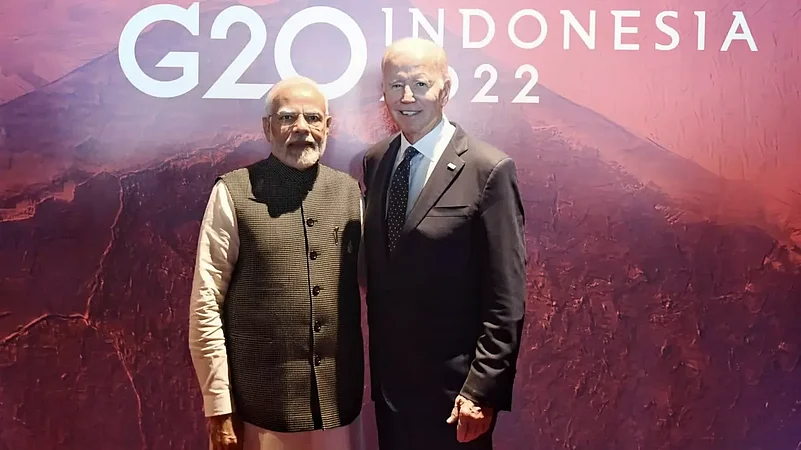Eric Garcetti, a close confidant of US President Joe Biden, has been confirmed as the next US Ambassador to India. It took nearly two and a half years for his appointment to be approved and the US embassy in New Delhi functioned without an ambassador during this period. But considering that India-US ties have improved dramatically since the civil nuclear deal was signed in 2005, it hardly made any difference to the bilateral relations.?
Technology To Be Next Frontier Of India-US Ties, Initiative on Critical Technology Takes Baby Steps
The United States wants India to develop as a balance to China in Asia. Economic growth and access to top-end technology is essential for New Delhi to be able to compete with China in the next decade or so.

High level visits are now routine and every senior member of the US government has been to India — a stark contrast to the past when such meetings were few and far between. When former President Bill Clinton visited New Delhi in 2000, it was after a break of almost 22 years. At the time, Jimmy Carter was the last President of the United States to have visited India in 1978.
Garcetti has task cut out for him. His efforts will be to ensure that India’s position on the Ukraine War comes closer to the US position. Washington has learnt the ropes of dealing with New Delhi. Americans realise that lecturing and hectoring India is not the answer. So, despite tremendous pressure on the Narendra Modi government to fall in line on Ukraine, senior administration officials like US Secretary of State Antony Blinken have not publicly made provocative comments on India’s position. Instead, the public comments have been conciliatory, talking of New Delhi’s long friendship with Russia and its dependence on Russian hardware for its military.?
India has also been buying defence equipment from the United States, so Washington is assured that over time the Indian dependence on Moscow will gradually come down. It is behind closed doors that tough arguments take place and little escapes to the public domain.
India’s concern, as many experts have pointed out, is the dilution of Washington’s focus on China amid the ongoing war in Europe and primacy to defeating Vladimir Putin over everything else. But Blinken has repeatedly reassured India that the United States as the pre-eminent power in the world is capable of keeping its focus both on Europe and Asia.
“We can run and chew gum at the same time,” said Blinken at the Raisina Dialogue, harking back to the time when late president Lyndon Johnson mocked another former president Gerald Ford with these words. ?
As India opened up and political relations with the United States have improved by leaps and bounds, trade has also gone up dramatically. Bilateral trade in the financial year 2021-22 rose to $119.42 billion, making the United States India’s top trading partner — replacing China that had earlier ruled the roost. Of India’s total trade, 11.5 per cent is now with the United States. These figures are slated to go up substantially as more US companies begin production lines in India under new partnerships.
Apart from security, India has always been keen on acquiring cutting-edge technology from the United States. Following India’s nuclear tests in 1974 and 1998, the United States had slapped sanctions on India’s scientific entities and ensured that Western nations do not collaborate with Indian scientists. However, all this is in the past. Now it is a different ballgame. ?
On February 1, the India-US Initiative on Critical and Emerging Technology (ICET) held its inaugural meeting. Washington is eager to help India’s high-tech industry as the US-China rivalry gets more pronounced by the day. In 1972, President Richard Nixon and his Secretary of State Henry Kissinger wooed China to cut the Soviet Union to size and helped China to become the economic super power it is today. Now Washington wants India to develop as a balance to China in Asia. Economic growth and access to top-end technology is essential for New Delhi to be able to compete with China in the next decade or so.
The first step in this direction was taken when the two countries held their first meeting for such cooperation. India and the United States are now set to promote bilateral collaboration on resilient semiconductor supply chains. Semiconductors are regarded as the brains of the electronic industry needed to produce a wide range of items from smartphones and laptops to cars and communication devices in military systems.
The Covid-19 pandemic-induced lockdowns had hit supply chains across the globe and countries realised the importance of creating multiple secure supply lines. India is hoping to benefit from the US -China technology rivalry that has led to Washington’s ban on American exports of semiconductors to China.?
A task force has been set up by the US Semiconductors Association and the India Electronics and Semiconductor Association to explore ways of taking the initiative forward and involving private companies. General Atomics (GA) of the United States and an Indian start-up called the 3rdiTech have announced that the two would work together to develop semiconductor technologies for defence sector. The Indian government has laid out the red carpet for such collaborations and has announced?up to $50 billion in incentives that could cover at least 50 per cent of the project’s costs. This was announced by the Narendra Modi government in 2021 to attract chip manufacturers set up joint ventures in India.
Advertisement
-
Previous Story
 'I Don't Know': Champai Soren Denies Rumours Of Switch To BJP; Himanta Sarma Praises His Contribution In Jharkhand
'I Don't Know': Champai Soren Denies Rumours Of Switch To BJP; Himanta Sarma Praises His Contribution In Jharkhand - Next Story


















